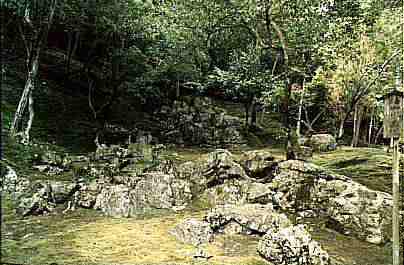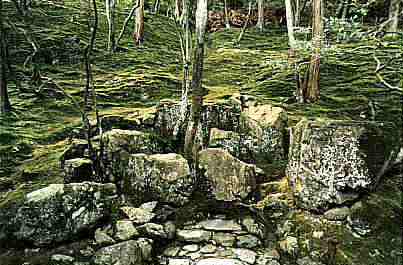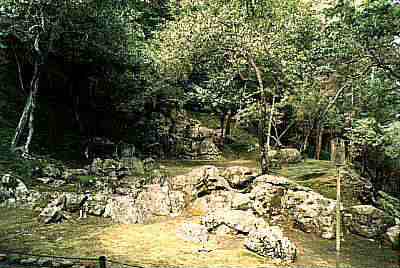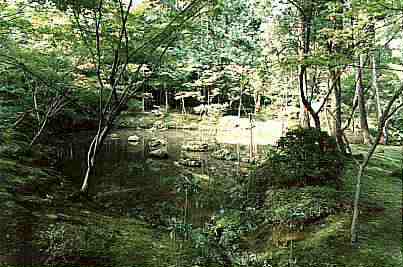
Kyoto Saiho-ji Garden




Saihoji Temples is popularly called "Koke-dera" or Moss Temple.True to its
Popular name,its garden is thickly covered with moss of many varieties.though
the garden is beautiful with its carpet of velvety moss,this fact has nothing
todo with the original design concept of this garden.
Another point which we must bear in mind regarding this gadebn is that it was
laid ibn the closing years of the Heian period through the early days of the
Kamakura Period(in the latter half of the 12th Century)l.It was not laid out,as
popularly believed,by the most Reveredend Zen Buddhist Priest Soseki Muso in
the Nanbokucho Period(1333-1392).
This garden ,which is of an ancient style dating far back beyond the days of
Rev.Musl,doubtlessly is one of the most celebrated gardens representative of
Japan.The garden in irself is an eloquent example of the out standing quality
of esthetic culture which flourished from dthe Period (from the 8th to 12th
Century).
The fact that this garden was designed in the latter half of the 12th Century
can be verified by the style and technique employed in its creation. this can
also be proved with literary evidence.
"Saihoji Engi"(History of Saihoji Temple),which is also called "Saihoji Chitei
Engi"(History of Saihoji Temple's Pond Garden)has a passage reading in effect
:
"Buddihist Saint Enro paid a visit to Matsuo Shrine in this area,created a pond
and perceived the majesty of Buddha".This was also written uin Genko Shakusho(annals
of Genko Years).In demarcating the compounds of the seven Buddhist temples of
Taninodo in the Rekio Era(1338-1340),Takuauji Ashikaga,a shogun of the 14th
Century,bulit a temple east of the pond created by Saint Enro and enshrinde
in it a statue of Jizo(guardian denity of children)which he himself had carved.Takauji
issued a decree saying that the territory lying west of this temple to the Saifukuji
Temple.
An account of Saint Enro in "genko Shakusho"says that Saint enro moved to the
Saifukuji Temple to the south of Mt.Matsuo in 1167,dug a huge pond and built
a temple overlooking the pond.
From these references, it can be surmised that the Saihoji garden which we see
today originally was laid out by Saint Enro as the pond garden of the Saifukuji
Temple.
The temple thus constructed was ruined and became deserted in the Kenkyu years
(1190-1199). Morokazu Nakahara,governor of the Province of Settsu (present Hyogo
Prefecture),built another temple there.Changing the affiliation of the Saifukuji
Temple to the Nenbutsu Sect,Morokazu split the temple into two and named one
Saihoji and the other Etoji.He appointed Saint Honen as the founder of Saihoji
and releasecd fish into the pond.
War and disturbances broke out after the death of Morokazu,causing the garden
to run into ruin.Morokazu's fourth generation grandson Chikahide Fujiwara(Nakahara)deplored
the devastated state into which the garden had fallen and, changing the temple's
affiliation to the Zen Sect in 1339,appointed Rev.Muso,an outstandinglandscape
gardener,to rehabilitate the temple.Rev.Muso Chinese ideographic characters
used in the name of Saihohi quarters on a scenic spot in the garden overlooking
the pone,which was completed during the years of ]saint Enro and Saint Honen.
Thus the History of thwe Saihoji Temple describes the origin of this Moss Temple.
The garden which belonged to the old Saihoji Temple is a pond garden whereas
the one which belonged to the Etoji Temple is a dry rock garden made up of rock
groupings which symbolize acascade, atortoise island and a crane island,and
a fountain well.
The pond garden was laid out in the style characteristic of the closing years
of theHeianperiod.The design of the garden is of the "Suhama"type after the
fashion of a sandy beach often depicted in Yamato-e paintings.The island in
the pond is what is called "Kasumi-no Shima"in "Sakutei Ki"(Manual of Landscape
Gardening)."Kasumi-no Shima",of mist-shaped island,consists of two islands of
white sand placed adjacent to each other.Both of them are devoid of trees of
plants.When they are viewed from a destance,they appear in the shape of a destored
S,which is the Japanese concept of a mist hanging low over the mountain,hence
the name "Kasumi-no Shima".Therefor, moss covering the island or trees growing
on it ded bnot enter into the original concept of this landscape garden.The
idea of decorating an island with moss or trees belonged to the Jodo Sect of
Buddhism and not to the Zen Sect of Buddhism.Because of these circumstances,it
is evident that this garden had been constructed long before Rev.Muso was assigned
to the Saihoji Temple.
![]() Caution!! Saihou-ji
Garden do not open.
Caution!! Saihou-ji
Garden do not open.